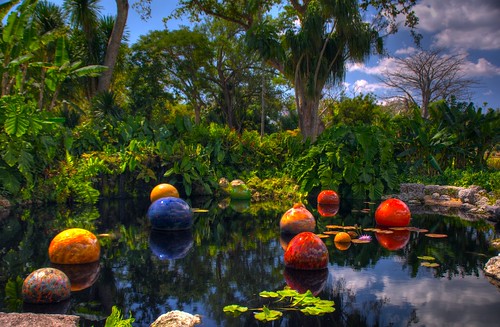The Psychadellic Earthiness of Fairchild
Inspired by the Fairchild Tropical Botanic Garden in Florida, Anya’s Garden perfume by the same name from presents the most unusual array of notes in the line. Full of exotic tropical aromas from both land and sea, it is a boisterous earthy explosion of hot and moist notes. I have never been to Florida, but after experiencing Fairchild I can imagine how intoxicating the humid tropical air must be, hosting such intense polarities.
Fairchild perfume is exotic and disturbing – you will smell here scents that you probably never smelled before: opening with the heady, unusual peppery-floral-horseradish notes of pandanus (kewda) and the bright, more familiar hesperidious notes of pink grapefruit and sweet clementine, Fairchild’s pungent opening will wake you up immediately and grab your attention with intrigue and puzzlement. Than notes champaca, magnolia and various jasmines rein the heart; though I personally feel the pandanus notes lingers longer than all and overshadows the presence of these glorious flowers. From the tree tops bearing tropical flowers and fruit, Fairchild goes deeper, and explores the moist soil and the luscious vegetation, with air-exposed roots intertwining amongst moss and seashells and ponds. The notes of beach-harvested ambergris and the toasted seashells are very muted and barely noticeable (the latter were also used in Tango by Aftelier in a larger amount), adding complexity to the base that is at times overbearingly earthy. Fairchild smells wet, hot and tropical and the contrast between the pungent and unusual kewda jutaxposed with moss and roots creates a peculiarly psychedelic earthy feel.
According to Anya’s Garden website, Fairchild includes notes of pandanus, champaca (gold and white), a few different types of jasmine, citrus notes (grapefruit, clementine), ylang ylang, and base notes of ambergris, oakmoss, seaweed, toasted seashells, hedychium roots and spicy galangal.
Anya McCoy is one of the pioneers of Natural Perfumery, and being a Landscape Architect, she has appropriately chosen to dedicate each perfume in her line to famous botanical gardens around the world such as Fairchild and Riverside (a citrus-ambery perfume which was recently discontinued) as well as imaginary/mythical ones, like her goat-haired fougere fragrance, Pan. Anya is also the queen of tincturing rare tropical flowers that she grows in her garden, and which do not submit their essences to any form of distillation. The tinctures give a certain depth and complexity as well as a vivid aura – as if the perfume is breathing with life.
Fairchild can be had via Anya's Garden webstore, in parfum Extrait (3.5ml for $40), Eau de Parfum (15ml for $80) or in sample spray size (2ml for $20). A smaller size sample, for one or two application is also available for $5.
To read other opinions of Fairchild, visit:The Perfume Bee
Perfume Shrine
Noteworthy Fragrances



